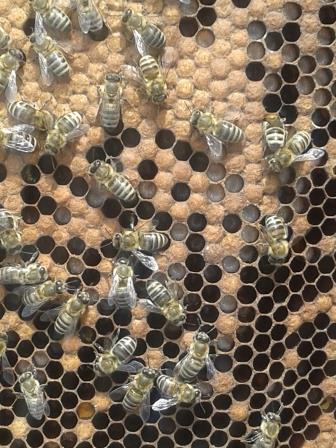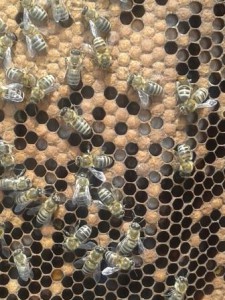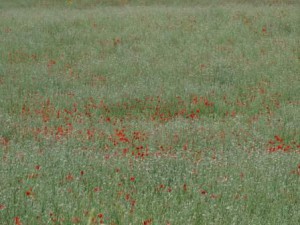22nd May 2015 Tashkent, Uzbekistan
World Biodiversity Day

 Over the last two years we have been keen buyers of local honey in Tashkent. One recent weekend we went to see where it comes from, and drove out of Tashkent to a meadow close to the hills behind Parkent. The beekeeper showed us the stack of hives stacked up on a large trailer, and explained how he tends the bee communities. We watched him introducing new queens into two of the hives, and he showed us how the bees build the cells in which their larvae are fed and develop into new generations of bees. It was disconcerting at first to be surrounded by flying, buzzing bees, but none of them was threatening or aggressive.
Over the last two years we have been keen buyers of local honey in Tashkent. One recent weekend we went to see where it comes from, and drove out of Tashkent to a meadow close to the hills behind Parkent. The beekeeper showed us the stack of hives stacked up on a large trailer, and explained how he tends the bee communities. We watched him introducing new queens into two of the hives, and he showed us how the bees build the cells in which their larvae are fed and develop into new generations of bees. It was disconcerting at first to be surrounded by flying, buzzing bees, but none of them was threatening or aggressive.
 The meadow flowers that dot the landscape give the honey its distinctive taste; but in return the bees play an essential role in fertilising the plants by transferring pollen from one to another – and this applies as much to cultivated plants as it does to the flowers of the meadow. In the UK, according to the British Beekeepers Association, about 70 crops are dependent on, or benefit from, visits from bees, and around a third of the food we eat would not be available but for bees. Bees also pollinate the flowers of many plants that become part of the feed of farm animals. The economic value of honey bees and bumble bees as pollinators of commercially grown insect pollinated crops in the UK has been estimated at over £200 million per year.
The meadow flowers that dot the landscape give the honey its distinctive taste; but in return the bees play an essential role in fertilising the plants by transferring pollen from one to another – and this applies as much to cultivated plants as it does to the flowers of the meadow. In the UK, according to the British Beekeepers Association, about 70 crops are dependent on, or benefit from, visits from bees, and around a third of the food we eat would not be available but for bees. Bees also pollinate the flowers of many plants that become part of the feed of farm animals. The economic value of honey bees and bumble bees as pollinators of commercially grown insect pollinated crops in the UK has been estimated at over £200 million per year.
Pollination is also a vital part of creating and maintaining diversity in the environment – worth remembering as we celebrate World Biodiversity Day. Biodiversity isn’t just about the glamorous species – tigers and snow leopards and saiga antelopes – but about everything that makes up the extraordinary complex networks of nature, in which ultimately everything is dependent on everything else.
The life of a bee, and the importance of bees in the global ecosystem, have inspired the British pavilion at the 2015 Milan Expo (http://bit.ly/1b8qrhj; http://www.ukpavilion2015.com). The UK Pavilion was designed by the British artist Wolfgang Buttress, and developed by British companies including Stage One, Rise and BDP. The Pavilion explains the crucial role of pollination in the food chain and the global challenge of sustaining honeybee populations. Visitors can follow the path of a honeybee through an orchard and wildflower meadow into the hive, the Pavilion’s centrepiece, a 17m high filigree aluminium sphere representing a beehive. The hive is filled with the sound of bees and wrapped in LEDs flickering in response to the movement of bees in a real hive, located in the UK. It illustrates the core theme of the Expo, “Feeding the Planet, Energy for Life”, aimed at highlighting one of the most pressing challenges of our time – how to feed and sustain an expected rise in the world’s population to 9 billion by 2050.
The meadows beyond Parkent are also full of birdsong, and I got up frequently from our shashlik lunch to look for the source of some new voice I didn’t recognise. They are a lovely example of biodiversity in practice. Long may they stay that way.